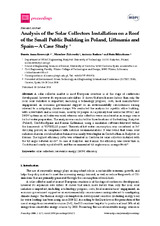Analysis of the Solar Collectors Installation on a Roof of the Small Public Building in Poland, Lithuania and Spain—A Case Study
Autor
Krawczyk, Dorota Anna
Żukowski, Mirosław
Rodero Serrano, Antonio
Bilinskiene, Ruta
Editor
MDPIFecha
2018Materia
Solar collectorsRenewable energy
DHW
Efficiency
METS:
Mostrar el registro METSPREMIS:
Mostrar el registro PREMISMetadatos
Mostrar el registro completo del ítemResumen
A solar collector market is most European countries is at the stage of continuous
development, however its expansion rate differs. It shows that much more factors than only the
local solar radiation is important, including a technology progress, costs, local manufactures’
engagement, an economic government support or an environmentally consciousness raising
relevant to a mitigating climate change. We conducted the analysis for a public office building,
with a few toilets and a social room, used by 54 people. As a primary heat source for HVAC and
DHW systems an oil boiler was used, whereas solar collectors were considered as an energy source
for hot water preparation. The analysis was conducted for three locations of the building: Bialystok
(Poland), Cordoba (Spain) and Kaunas (Lithuania), using a simulation software delivered within
the framework of VIPSKILLS project. Theoretical hot water consumption was considered as 3–7
dm3/(day person) in compliance with national recommendations. It was found that beam solar
radiation share in a total radiation balance was nearly twice higher in Cordoba than in Bialystok or
Kaunas. The highest efficiency (44%) was estimated in Cordoba for solar collectors installed with
the tilt angle between 45–50°. In case of Bialystok and Kaunas the efficiency was lower than in
Cordoba and nearly equal 40–41% and the recommended tilt angle was in a range 30– 45°.

